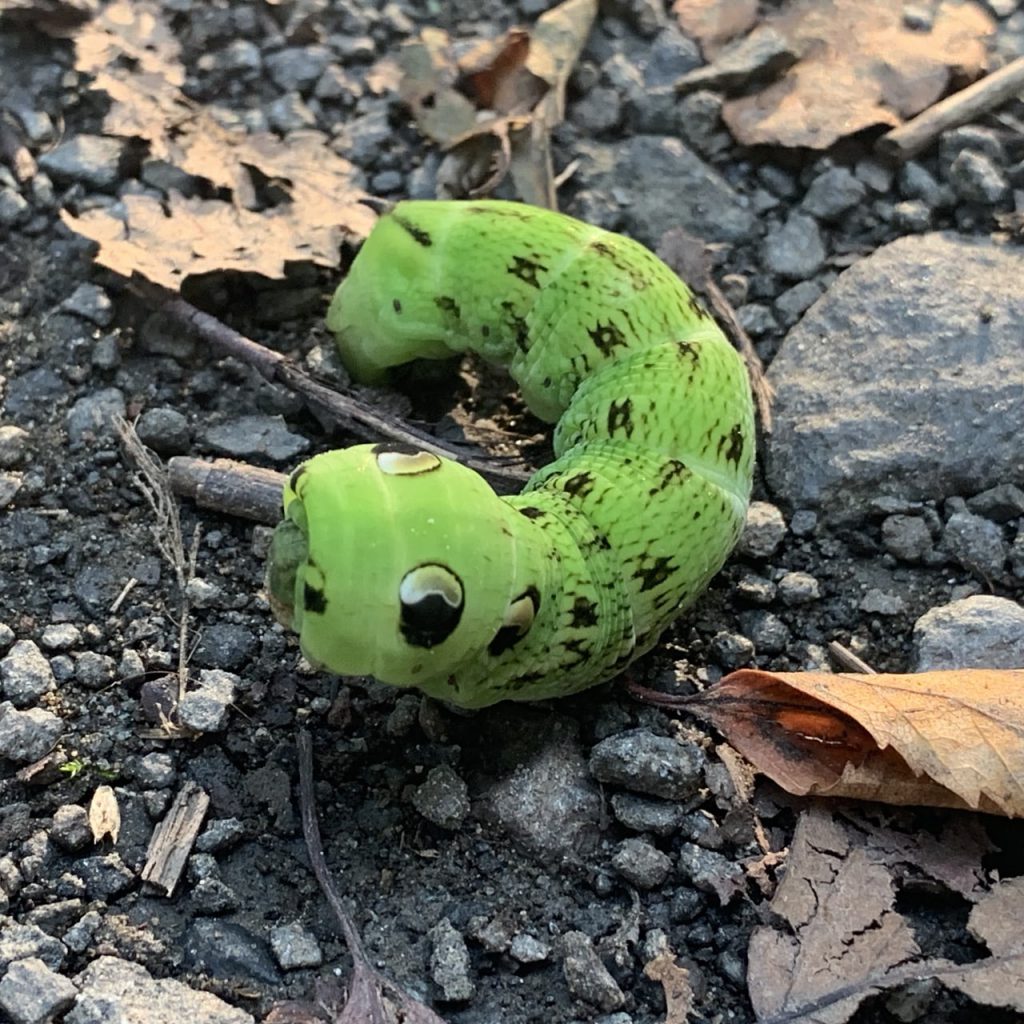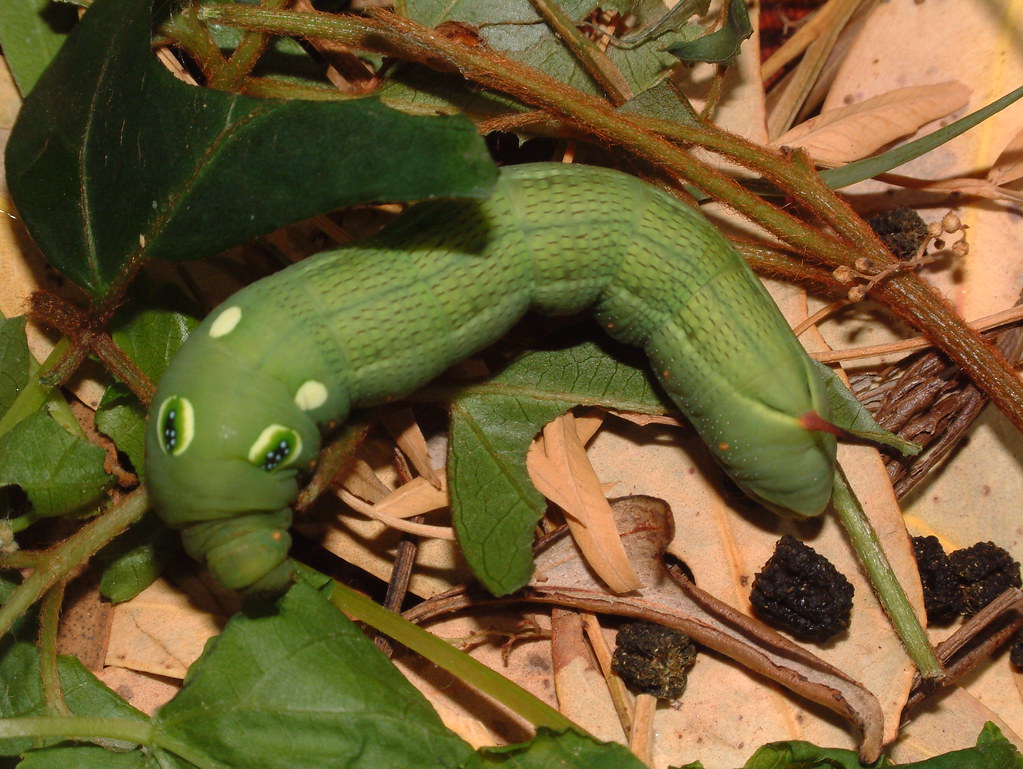
Privet Hawk Moth Caterpillar by TerryMcK ePHOTOzine
Hyles linearis T. P. Lucas, 1892. Phryxus australasiae Tutt, 1904. Hyles livornicoides, the Australian striped hawk moth, is a moth of the family Sphingidae first described by Lucas in 1892. The larvae are known by the common name Yeperenye caterpillar, in the Arrernte language the caterpillars are referred to as Ayepe-arenye .

Hawk Moths The Australian Museum
A really cool looking caterpillar. Initially this caterpillar is green with a strong nearly straight horn on its tail pointing backwards. Later it develops a series of diagonal white stripes on its sides. This is a fully developed caterpillar and has grown to its full length of about 8 cms. Psilogramma casuarinae is found in eastern Australia and was long treated as a synonym of the Asian.

Australian Hawk Moth (Sphingidae) caterpillar 1 Stephen Mudge Flickr
The caterpillars of the Privet Hawk Moth are commonly seen in Sydney feeding on privet. They also eat jasmine and a number of other plants. Other behaviours and adaptations. When disturbed, male Privet Hawk Moths may make a hissing sound by rubbing together a specialised set of scales and spines at the end of the abdomen.

Vine Hawkmoth Caterpillar from Australia What's That Bug?
The Sphingidae are a family of moths commonly called sphinx moths, also colloquially known as hawk moths, with many of their caterpillars known as "hornworms"; it includes about 1,450 species. [1] It is best represented in the tropics, but species are found in every region. [2]
Vine HawkMoth Caterpillar Project Noah
Unlike most moth families in Australia, the hawk moth family (Sphingidae) is well known. These large and attractive moths have long attracted the attention of taxonomists. And the family is not well-represented here. There are at least 1200 species worldwide, but only around 60 occur Australia. is one of the largest of our hawk moths.

Five Spotted Hawk Moth Caterpillar Focusing on Wildlife
MEET THE PELLUCID hawk moth (Cephonodes hylas), a gorgeous cross between a moth, a cicada, and a glasswinged butterfly.At home in an array of habitats across Africa, India, Southeast Asia, and in Queensland, Australia, this strange little species starts off as a bright green caterpillar, feeding upon some of the finer things in life - coffee and pomegranate plants - wherever it can find them.

Vivid green horned caterpillar of Australian hawk moth Acosmeryx anceus, legs hanging onto stem
Hawk Moth Caterpillar Many hawk moth caterpillars eat toxins from plants, but don't sequester them the way milkweed butterflies do. Most toxins are excreted. Continue Reading after the facts. Advertisement Hawk Moth Caterpillar Scientific Classification Kingdom Animalia Phylum Arthropoda Class Insecta Order Lepidoptera Family Sphingidae

Elephant Hawkmoth Butterfly Conservation
This is the king of the autumn caterpillars, a voracious eater that grows into a sizeable creature up to 7cm long with large spots along its body and a white-tipped spine at the end. It feeds on tender foliage, and can decimate a patch of impatiens or sweet potato in a couple of days.

Elephant Hawk Moth caterpillar
Impatiens Hawk Moth. The caterpillar of the Impatiens Hawk Moth, Theretra oldenlandiae, is a common visitor to suburban Sydney gardens.. Moths of Australia. Melbourne University Press: Carlton. Moulds, M.S. 1998. New larval food plants for Australian hawk moths (Lepidoptera: Sphingidae).

Hawk Moth Caterpillar, Alice Springs, Central Australia. Flickr
Mature Hawk Moth Caterpillars are usually stout, with cylindrical hairless body and small head. They usually have a prominent tapering horn on their last segment. They have strong prolegs on 3, 4, 5, and 6 segments.. Moths of Australia - I. F. B. Common, Melbourne University Press, 1990, p408. 2.
Australasian Privet Hawkmoth Caterpillar Project Noah
Found in the northern regions of Western Australia, the Northern Territory and Queensland, and all across South-East Asia, this moth has evolved an ingenious way to find mates - even if they're several kilometres away.

Impatiens Hawkmoth Caterpillar from Australia What's That Bug?
The hawk moth caterpillar is a truly fascinating creature, with a life cycle that is both intriguing and captivating. Understanding the various stages of its development can provide a deeper appreciation for the marvels of nature. In this article, we will explore the characteristics, habitat, and distribution of the hawk moth caterpillar, as.

Hawk moth caterpillars in Townsville
Hawk moths SPHINGIDAE Smooth, hides by day, destroys lawns and crops at night: Cutworms and Armyworms NOCTUIDAE Hairy, especially with four tussocks on the back: LYMANTRIIDAE Just hairy: ARCTIIDAE , ANTHELIDAE , NOTODONTIDAE Smooth and walks in a looper fashion: GEOMETRIDAE , CATOCALINAE , PLUSIINAE

Bug Pictures Convolvulus Hawkmoth (Agrius convolvuli) by kennedyh
forewings The SPHINGIDAE are called Hawk Moths because they can fly very fast, and can also hover in flight. They use this latter ability to sip nectar from flowers using their long haustellum (tongue), when they fly in the evening. They are large moths with long narrow forewings, and smaller hindwings.

Vine Hawkmoth Caterpillar from Australia What's That Bug?
The Australian Striped Hawk Moth ( Hyles livornicoides ), whose larvae are known as the Yeperenye / Yipirinya Caterpillar is a sacred totemic ancestral being for the Arrernte people of Alice Springs in Central Australia. The Australian Striped Hawk Moth at the entrance of the Yeperenye Shopping Centre

NixPages FRIDAY GREENS 67 CATERPILLAR
The green caterpillars also have a blue head, and spiracles. A blue line bordered in white is also seen running across the upper parts of their body. The sub dorsal line appear whitish ending in a yellowish streak towards the base of their horn. Their black counterparts have a pale orange or brown head. Pellucid Hawk Moth Caterpillar.